

National Center for Science Education - Defending the Teaching of Evolution in Public Schools. Strange and Unusual Things! Interactive Science Notebooks. Those of you that follow know that I am just crazy about interactive science notebooks.
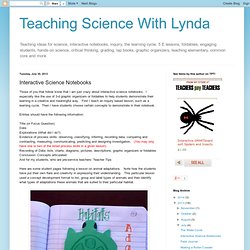
I especially like the use of 3-d graphic organizers or foldables to help students demonstrate their learning in a creative and meaningful way. First I teach an inquiry based lesson, such as a learning cycle. Then I have students choose certain concepts to demonstrate in their notebook. Entries should have the following information: Title (or Focus Question) Date Explorations (What did I do?)
Here are some student pages following a lesson on animal adaptations. The tri-fold give them plenty of room to write their great ideas and conclusions. In a related lesson, student learned about Camouflage and Mimicry. Because the pale moths sat quietly on the pale lichens during the day, predatory birds could not easily see them. Students colored a paper moth and hid it in the hallway for others to find.
Learningcenter.nsta.org/files/PB181Xweb.pdf. Learningcenter.nsta.org/files/PB228Xweb.pdf. MARE's Build a Fish. This resource can be used to complement instruction on ocean habitats as well as a general lesson on adaptations.

Make sure that students see that there are a variety of fish that can survive in each habitat, but that some combinations (of body parts, coloration, etc.) are better than others. This interactive is most appropriate for grade levels 3-5 and 6-8. Younger students may wish to take advantage of the “Who Lives Here?” Link that provides an example of an actual fish that lives in a particular habitat. Animal Adaptations 3-5 | Interactive Food Webs in the Bay 6-8 | Oceans 6-8 | Hands-On Marine Reserves 6-12 | Audio Coral Reef Adventure Fun Zone 3-8 | Interactive. Charles Darwin and On the Origin of Species. Photo Credit: Clipart.com No conversation about evolution is complete without a discussion of British naturalist Charles Darwin and his biological studies touchstone, On the Origin of Species, which introduced evolution to the general public.
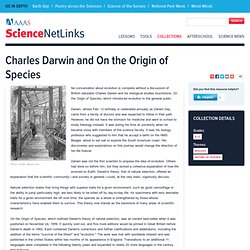
Darwin, whose Feb. 12 birthday is celebrated annually as Darwin Day, came from a family of doctors and was expected to follow in their path. However, he did not have the stomach for medicine and went to school to study theology instead. It was during his time at university when he became close with members of the science faculty. It was his biology professor who suggested to him that he accept a berth on the HMS Beagle, about to set sail to explore the South American coast. Darwin was not the first scientist to propose the idea of evolution. Natural selection states that living things with superior traits for a given environment, such as good camouflage or the ability to jump particularly high, are less likely to be killed off by day-to-day life. Sixth, Seventh, and Eighth Grade Lesson Boosters for any ...
Ciencia. Darwin e a Árvore da Vida Thursday, February 12th, 2009. Natural Selection. Abstract Using a variety of beans, students will investigate how various microbes can survive and reproduce.
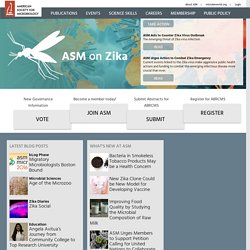
They will explain the effects the environment has on the sustainability of a microbial community and the adaptations they need to make for survival. Intended Audience Learning Objectives By completing this activity, the student will be able to: Describe the process of natural selection.Model the natural selection processIdentify and explain the environmental aspects (selective pressures) that influence natural selection.Predict why certain species have the ability to adapt and survive selective pressures.Explain the importance of natural selection among microbial communities. Necessary Student Background. MTS21 - Andrew Knoll - Ancient Life & Evolution. Dr.
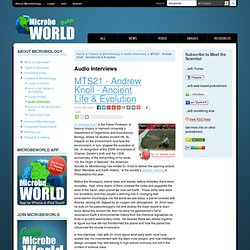
Andrew Knoll is the Fisher Professor of Natural History in Harvard University’s Department of Organismic and Evolutionary Biology, where he studies ancient life, its impacts on the environment, and how the environment, in turn, shaped the evolution of life. In recognition of the 200th anniversary of Charles’ Darwin’s birth and the 150th anniversary of the first printing of his book, “On the Origin of Species”, the American Society for Microbiology has invited Dr.
Knoll to deliver the opening lecture, titled “Microbes and Earth History,” at the society’s general meeting in Philadelphia this year. Before the dinosaurs, before trees and leaves, before trilobites, there were microbes. Charles Darwin's Game of Survival. Understanding Evolution. Goodall, Fossey & Galdikas: Great Minds. Tree of Life Web Project. Life Science. Learning Goals Which skull is a lizard and which is a snake?
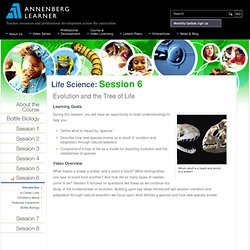
During this session, you will have an opportunity to build understandings to help you: Define what is meant by “species.” Describe how new species evolve as a result of variation and adaptation through natural selection. Life Science. Learning Goals Natural variation During this session, you will have an opportunity to build understandings to help you: Recognize how populations vary with regard to inherited traits Distinguish between DNA, chromosomes, and genes Relate genes to variation in populations Describe the process of adaptation through natural selection Video Overview.

My Brother the Ape - They Might Be Giants. Chimps Face Death Like Humans Do. Extraordinary Adaptation. "The Ring of Truth: Atoms" featuring Julia Child. Cuttlefish: Chameleons of the Sea. King Weed - They Might Be Giants (official video) What Do Visitors Really Know about Evolution? Microwaving the World. Earth-Building Wounds. Skeletons Reveal Human and Chimpanzee Evolution.